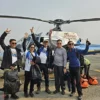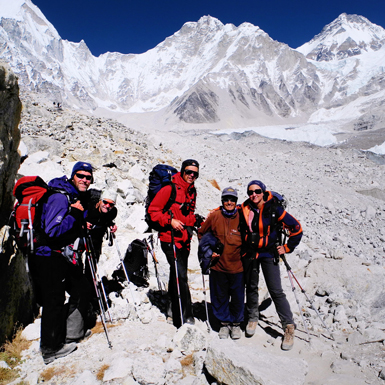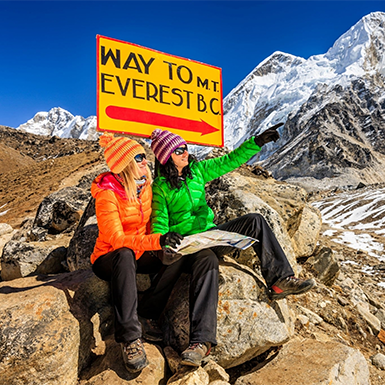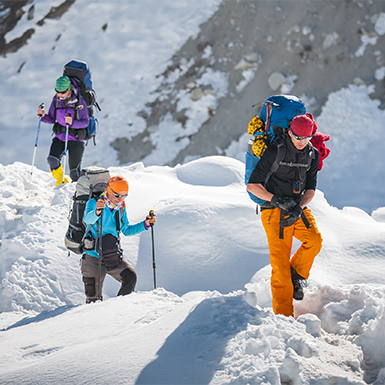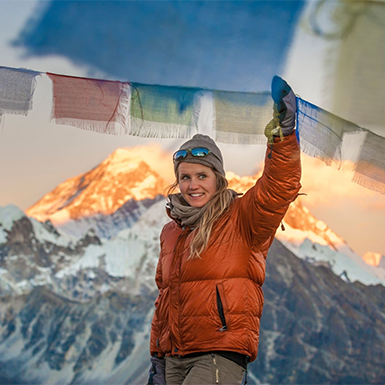Based on 5 reviews

Everest Base Camp Trek with Helicopter Return
Feel the Luxury and Shorten your Everest Base Camp Trek with Helicopter Return
Duration
Meals
- 09 Dinners
- 08 Lunches
- 10 Breakfasts
Accommodation
- 02 nights hotel
- 09 nights eco-lodge
Activities
- Trek to EBC
- Flyback by Heli
- Sightseeing
SAVE
€ 550Price Starts From
€ 2750
Overview of Everest Base Camp Trek with Helicopter Return
The Luxury Everest Base Camp Trek with helicopter return is a concise yet thrilling option for those with tight schedules or limited vacation days. This journey offers a perfect balance of adventure and value, ensuring every second and investment is well-spent.
Trekkers trek to the Everest Base Camp from Lukla, navigating through captivating landscapes with the towering Himalayan peaks as a constant companion. The highlight isn’t just reaching the base camp and the unmatched aerial vistas during the helicopter ride back to Kathmandu. This bird’s-eye view showcases the vastness of the Himalayas, providing a unique perspective of their magnificence.
Everest Base Camp Trek with Helicopter Return Highlights
- Delving into the rich cultural tapestry and age-old traditions of the Kathmandu Valley.
- Journeying as one family, guided by our seasoned team of experts and support crew.
- Marveling at the untouched splendor of peaks like Mt. Everest, Mt. Lhotse, and Mt. Cho Oyu.
- Immersing oneself in the tales and lore of the Himalayas, enriched by the vibrant narratives of the Sherpas.
- Engaging in commerce at Namche Bazaar, a pivotal trading hub for the Sherpa community.
- Relishing the comforts and delectable cuisine offered by top-tier hotels and lodges.
- Experiencing the exhilaration and sense of accomplishment as you climb towards the base camp.
- Enjoying unparalleled flight experiences, both to Lukla and the helicopter return from Kala Patthar.
Scaling the heights to reach the Everest Base Camp is a monumental accomplishment, given that Mt. Everest stands as the tallest peak in the world. The exhilarating expedition commences in Lukla, leading adventurers through dense forests, past traditional Sherpa settlements, and amidst serene green woodlands.
As you trek, you’re flanked by deep gorges and swift rivers, starkly contrasting the stark and frigid terrains shadowed by the colossal mountain ranges. This journey not only challenges one’s physical limits but also offers a unique insight into the rustic mountainous lifestyle of the Nepalese inhabitants.
View from Everest Base Camp Trek with Helicopter Return
You are presented with a panoramic vista of majestic mountain peaks from the Everest Base Camp trek with a helicopter return. This includes the iconic Mt. Everest at 8,848 meters, followed by peaks such as Mt. Lhotse (8,516m), Mt. Nuptse (7,855m), Mt. Pumori (7,161m), Mt. Changaste (7,550m), Mt. Lingerie (6,679m), Mt. Amadablam (6,856m), Mt. Thamserku (6,723m), Mt. Kongde (6,011m), Mt. Twache (6,367m), Mt. Cholaste (6,335m), Island Peak (6,179m), and Lobuche Peak (6,145m).
Additionally, you’ll witness Pokalde Peak (5,806m) and Honku South Peak (6,119m). Beyond these towering summits, the aerial perspective offers breathtaking views of the trail you’ve traversed, the intricate terraced farmlands, and the diverse landscape. After marking your journey at the Luxury Everest Base Camp Trek with Helicopter Return, you’ll be whisked back to Kathmandu via helicopter, concluding a truly unforgettable experience.
Detail Itinerary of Everest Base Camp Trek with Helicopter Return
Day 01: Kathmandu Arrival and transfer to hotel
Upon arrival at Tribhuwan International Airport (TIA), a Peregrine Tour Nepal representative will greet and welcome you after post-customs clearance. They will then escort you to your hotel.
Later in the evening, a briefing session will be organized at the hotel to provide details about the tour and logistics. This will also be an opportune moment to familiarize yourself with fellow travelers. Additionally, we will introduce you to the team members guiding you throughout the Everest Base Camp Trek with Helicopter Return. During this session, we will offer some light refreshments and snacks.
Please submit all necessary documents today, with a particular emphasis on your travel insurance details.
Meals: Not provided.
Day 02: Lukla flight and trek up to Phakding (2651 meters) 8 km distance, 3 hours trek
We’ll head to the airport in the morning for a scenic 35-45-minute flight from Kathmandu to Lukla. This brief journey offers a captivating transition from the urban sprawl of Kathmandu to the towering mountain peaks.
Upon landing in Lukla (2860m), we’ll rendezvous with the rest of our team members. After ensuring everything is in order, our trek towards Phakding village commences. This 3-4 hour trek offers glimpses of the revered Khumbila Mountain (5751m) as we pass through Cheplung. Our path also takes us alongside the Dudh Koshi River, culminating in a gentle walk to Phakding village.
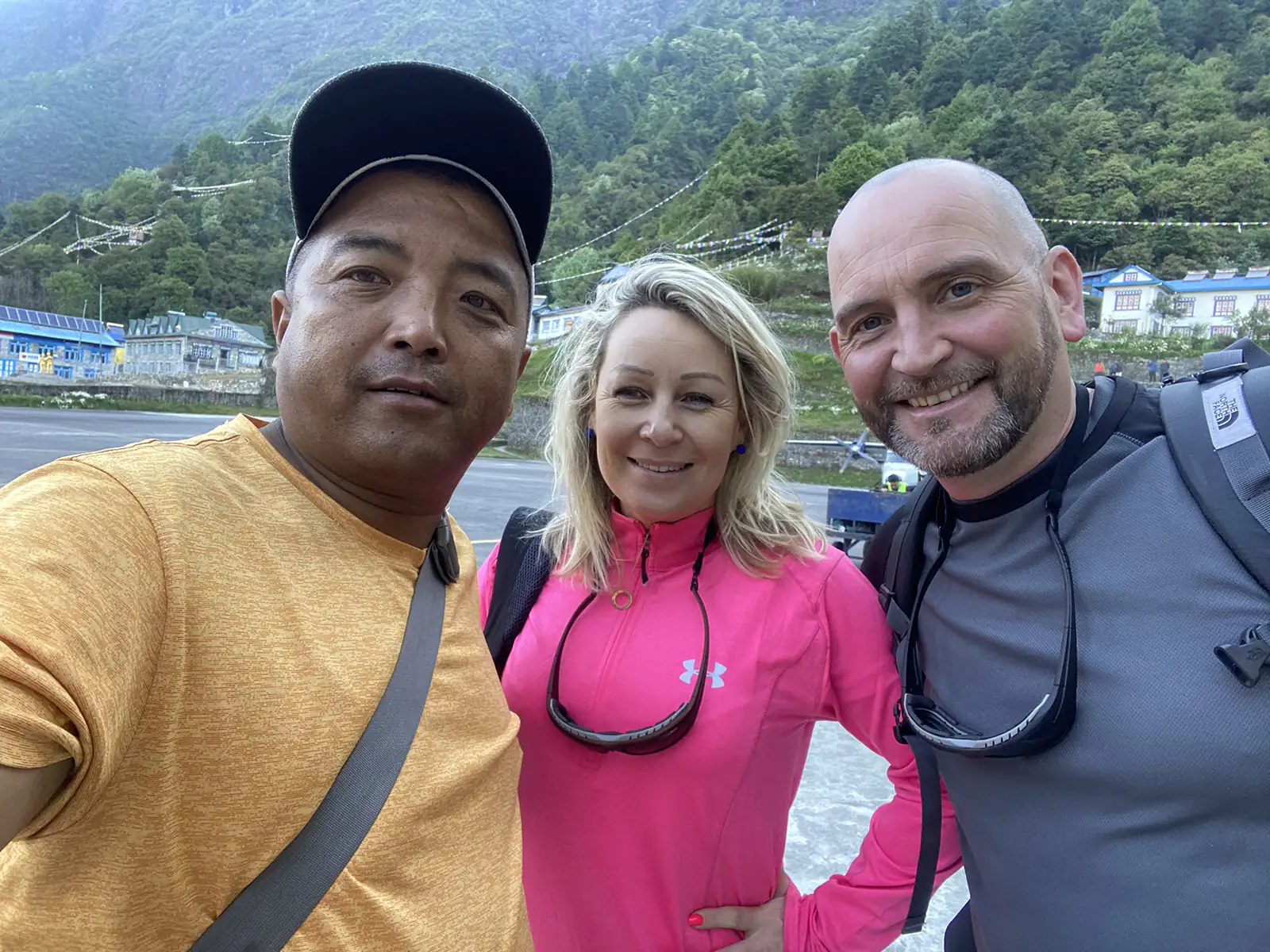
From Phakding, the Kusum Kangraru Mountain graces our view. This northern valley town of Lukla boasts a range of accommodations, from quality lodges and hotels to cozy guest houses catering to tourists and trekkers alike. We’ll be spending our night here.
Meals: Breakfast, Lunch, and Dinner.
Day 03: Trek to Namche (3440 meters) 11km distance, Approx. 7 hours
After a hearty breakfast, we’ll set out towards Namche Bazaar. As we hike, the sheer beauty of the mountains unfolds, instilling a growing sense of anticipation for the adventures ahead. Our path meanders through picturesque pine forests and open terrains, leading us to a steel suspension bridge that spans the icy Dudh Koshi River.
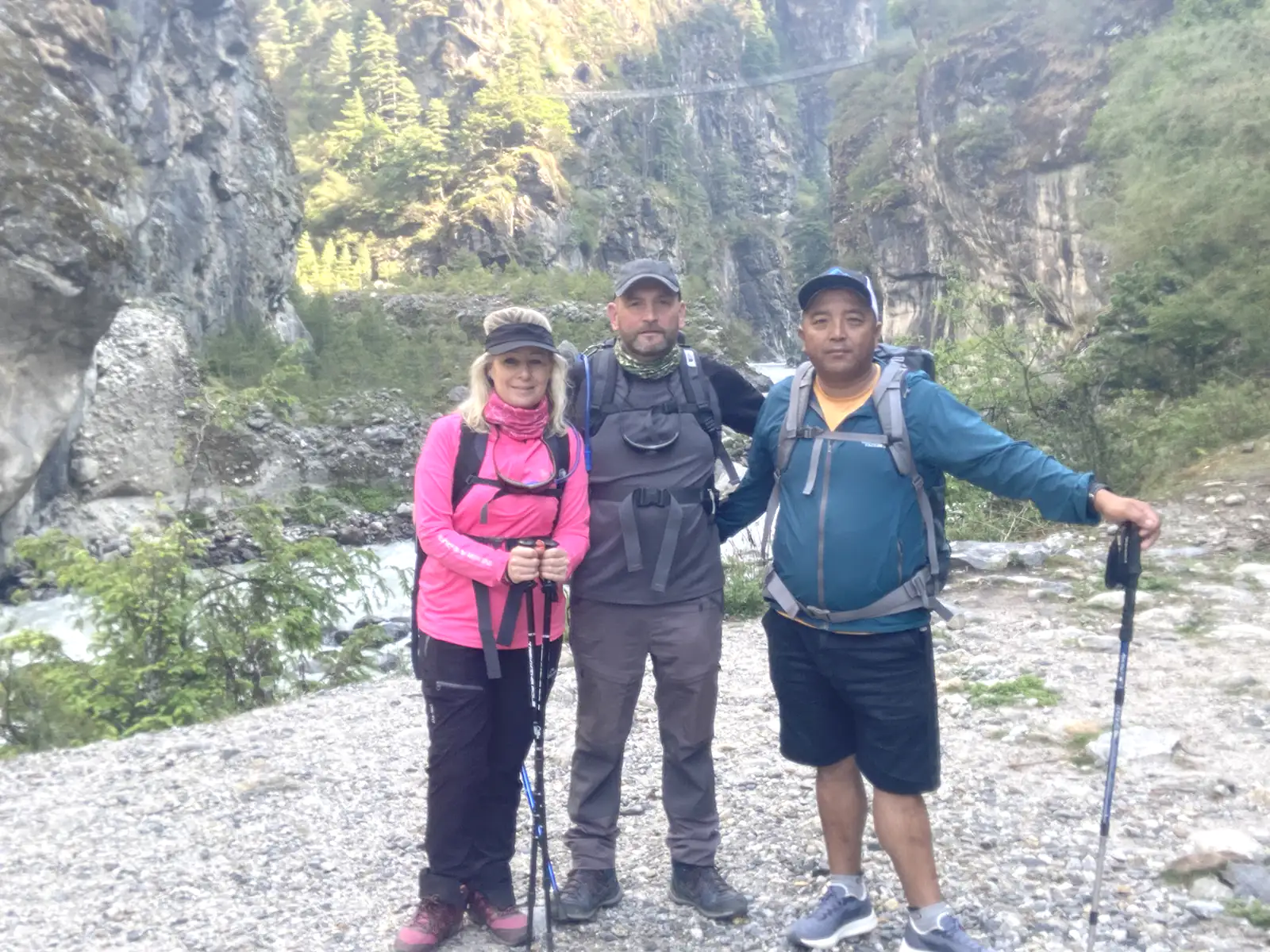
Our trek also takes us alongside the Bhote Koshi, a tributary of the Koshi river system. As we progress, we’re treated to splendid views of mountains like Mt. Nupla (5885m) and Kongde Ri (6093m). Further into our journey, after crossing the Kusum Khola, we’re greeted by the sight of Mt. Kusum Kangraru, majestically positioned to the east at the valley’s head. Along the way, it’s common to encounter fields dotted with donkeys and yaks, burdened with trekking equipment and goods for trade.
As we continue our journey, those unfamiliar with Mani stones will soon encounter them, engraved with the sacred mantra of Buddhists and Brahmins: “Om Mani Padme Hum.” This mantra translates to “Hail to the jewel in the lotus.” Along the way, the imposing Mt. Thamserku (6808m) becomes visible at a bend in the trail.
Upon crossing the Monjo pass, we enter the Sagarmatha National Park, a sanctuary teeming with lush vegetation and diverse wildlife, including the elusive red pandas and sturdy yaks. Our path then leads us upwards to Namche Bazaar, the Sherpa capital. This bustling hub is a vital trading center for Tibetans and Sherpas in the surrounding valleys. If the skies are clear and fortune favors us, we might even be treated to our inaugural view of the majestic Mt. Everest.
To aid in acclimatization and rest, we’ll spend the next two nights in Namche Bazaar, allowing us some respite before continuing our adventure.
Meals: Breakfast, Lunch, and Dinner
Day 04: Acclimatization day to avoid high altitude for coming days
While today is primarily dedicated to acclimatization due to the higher altitudes, Namche Bazaar offers many activities to keep us engaged. As the region’s primary trading hub, Namche Bazaar bustles with activity, housing museums, bakeries, coffee houses, a monastery, and the ever-vibrant market. For those keen on understanding the local culture, our guides can lead you to the museum, offering insights into traditional Sherpa life.
For a taste of altitude, we can ascend to Syangboche and visit the Everest View Hotel, renowned for being the world’s highest-altitude hotel. From here, one can behold the grandeur of mountains, including the iconic Everest.
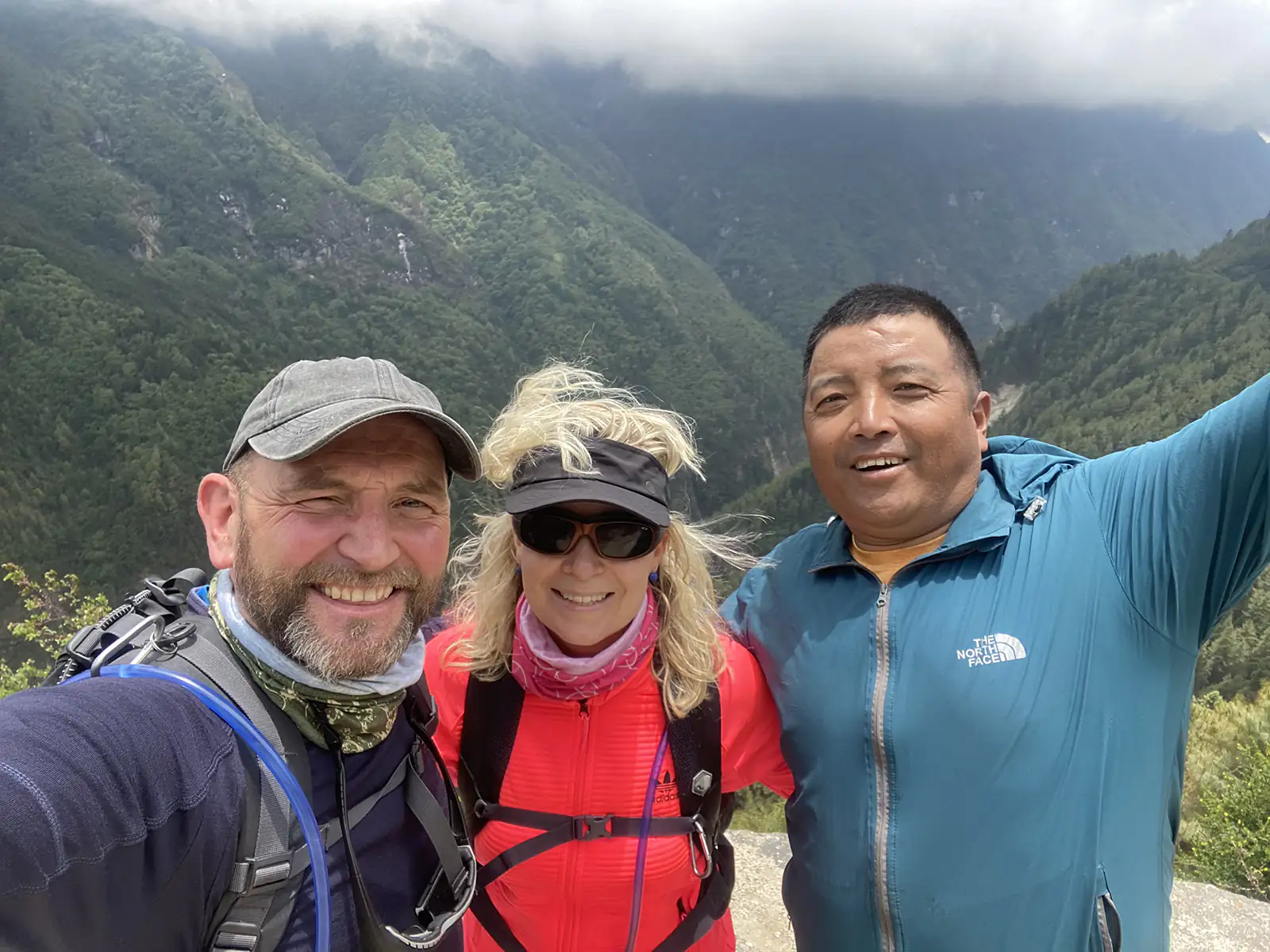
An early morning hike within the Sagarmatha National Park might reward us with a mesmerizing sunrise, illuminating peaks like Mt. Everest, Mt. Lhotse, Nuptse, and Ama Dablam. Further uphill from Syangboche, a viewpoint unfurls a sweeping view of Namche village.
As dusk approaches, a stroll through the vibrant streets of Namche Bazaar can be delightful. Perhaps indulge in some last-minute shopping or soak in the local ambiance. And, of course, no visit to Namche Bazaar is complete without savoring its tea or coffee. We’ll ensure you get your morning and evening brews, making your stay here all the more memorable.
Meals: Breakfast, Lunch, and Dinner
Day 05: Trek to Tengboche (3870 meters) 10km distance, Approx. 6 hours
As we journey towards Tengboche today, we are graced with uninterrupted vistas of the Himalayan giants, including Mt. Everest, Mt. Lhotse, and Mt. Ama Dablam, among others.
Our path takes us downward alongside the Dudh Koshi River, only to ascend through lush forests dominated by vibrant Rhododendron Trees. Traversing through several Sherpa villages, we gain insights into their rich culture and way of life.
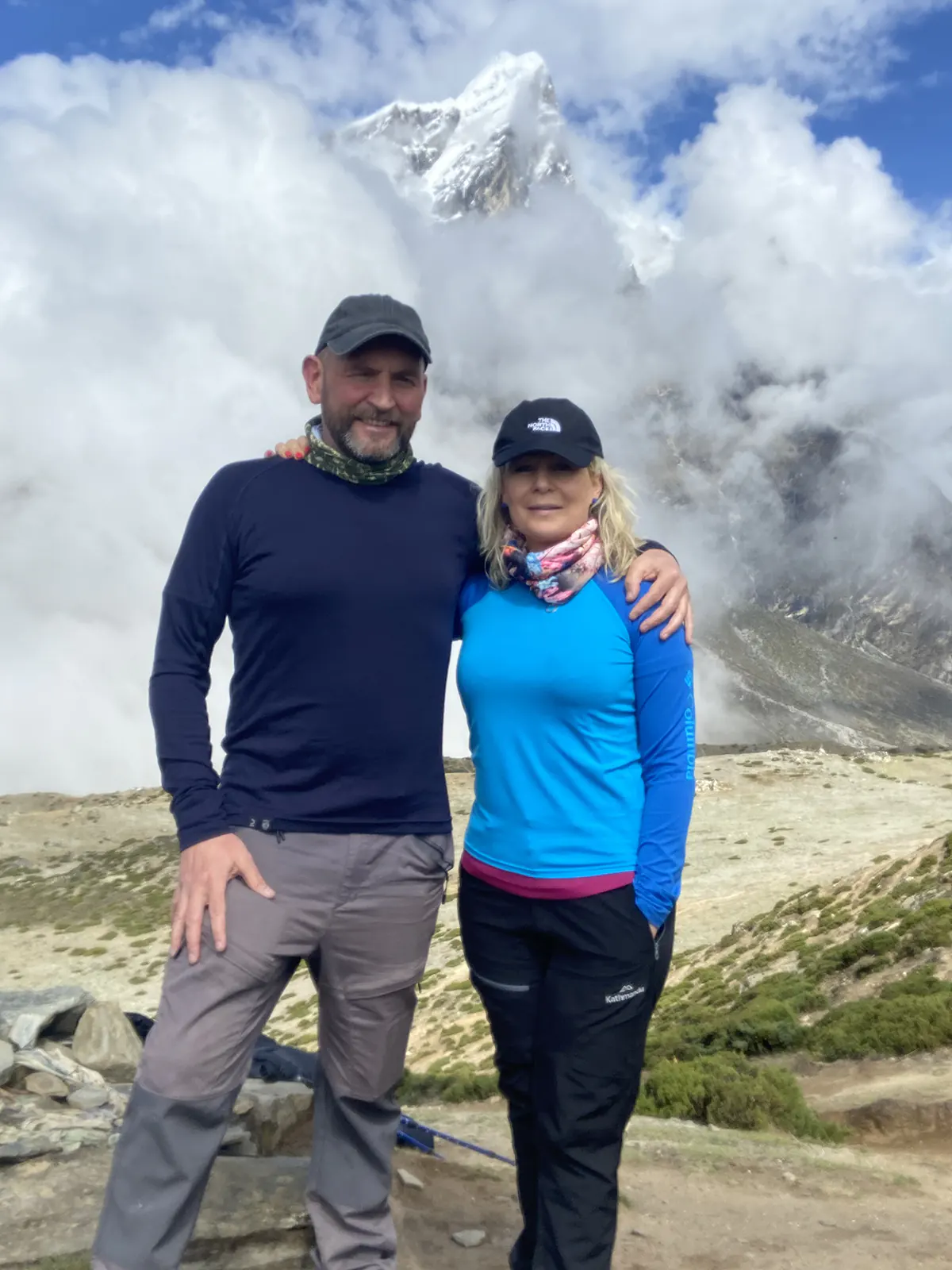
Tengboche, renowned for housing the region’s largest monastery – the Tengboche Monastery- is a spiritual beacon for the Khumbu inhabitants. Nestled amidst pristine forests, this monastery is an architectural marvel and a testament to the Sherpas’ deep-rooted faith. Tonight, we find solace in Tengboche, making it our resting haven.
Meals: Breakfast, Lunch, and Dinner
Day 06: Trek to Dingboche (4360 meters) 9 km distance, Approx. 5 hours
This morning, our journey takes us from Tengboche to Dingboche, with the grandeur of the Himalayas and the lush beauty of forests and rhododendrons as our constant companions. Our path leads us on a steep descent along the Imja Khola, a tributary of the Dudh Koshi River, guiding us to the village of Pangboche.
Positioned directly across from Mt. Ama Dablam, Pangboche offers a breathtaking panoramic view of this iconic peak. Along the way, our trek is enriched by encounters with Buddhist pilgrims, the spiritual tranquillity of monasteries and gompas in Pangboche, and the reverence of sacred Mani walls.
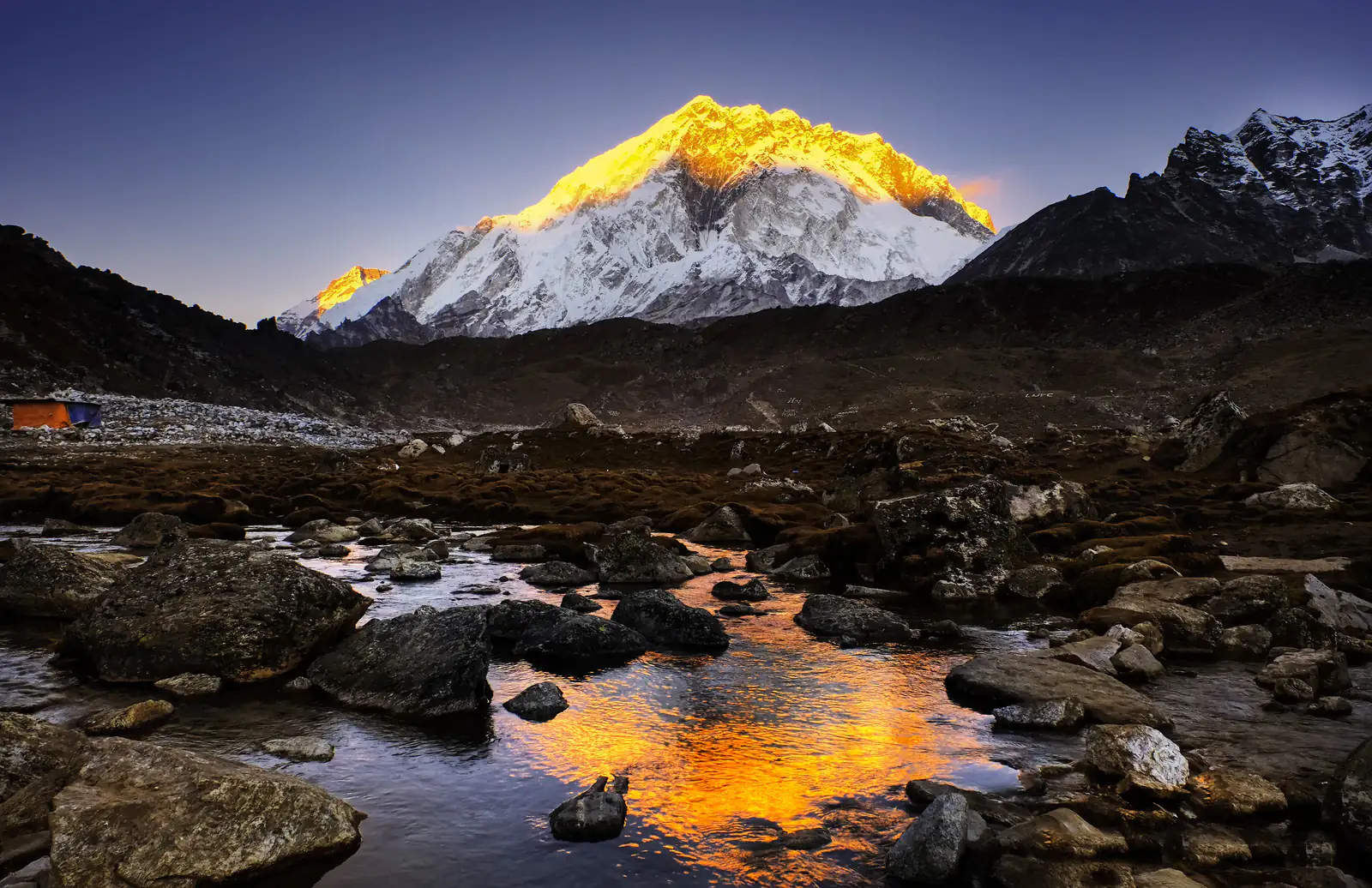
Upon reaching Dingboche, we’re captivated by the picturesque beauty of its crop fields. Often referred to as the “Summer Valley” of the region, Dingboche boasts kilometers of stone walls meticulously constructed to shield crops from the biting cold winds and wandering animals. Tonight, we find comfort and rest in Dingboche.
Meals: Breakfast, Lunch, and Dinner
Day 07: Dingboche 2nd acclimatization day
Dingboche village serves as a serene haven for trekkers and mountaineers en route to iconic peaks like Mt. Everest, Ama Dablam, and Imja Tse. Characterized by its verdant landscape, Dingboche is encircled by protective stone walls that safeguard essential crops such as buckwheat, barley, and potatoes. We have allocated an entire day here to acclimatize and immerse ourselves in the village’s tranquillity.
Today offers a plethora of engaging activities. For those seeking panoramic views, a trek to Nagerjun Hill unveils a majestic panorama of mountains, including Makalu, Lhotse, and Ama Dablam. History and spirituality enthusiasts can hike to the ancient Buddhist heritage site, Nangar Dzong. Additionally, for those looking for a more challenging ascent, Dolma Ri Peak beckons, easily accessible by foot and promising unparalleled vistas from its summit.
Meals: Breakfast, Lunch, and Dinner
Day 08: Trek to Lobuche (4940 meters) 7 km distance, Approx. 6 hours
Rejuvenated from our day of rest, we resumed our expedition with renewed vigor. As we journeyed, the pristine snow-capped peaks of Cholatse and Tawache stood sentinel, signaling our entry into more remote terrains than the bustling lower regions.
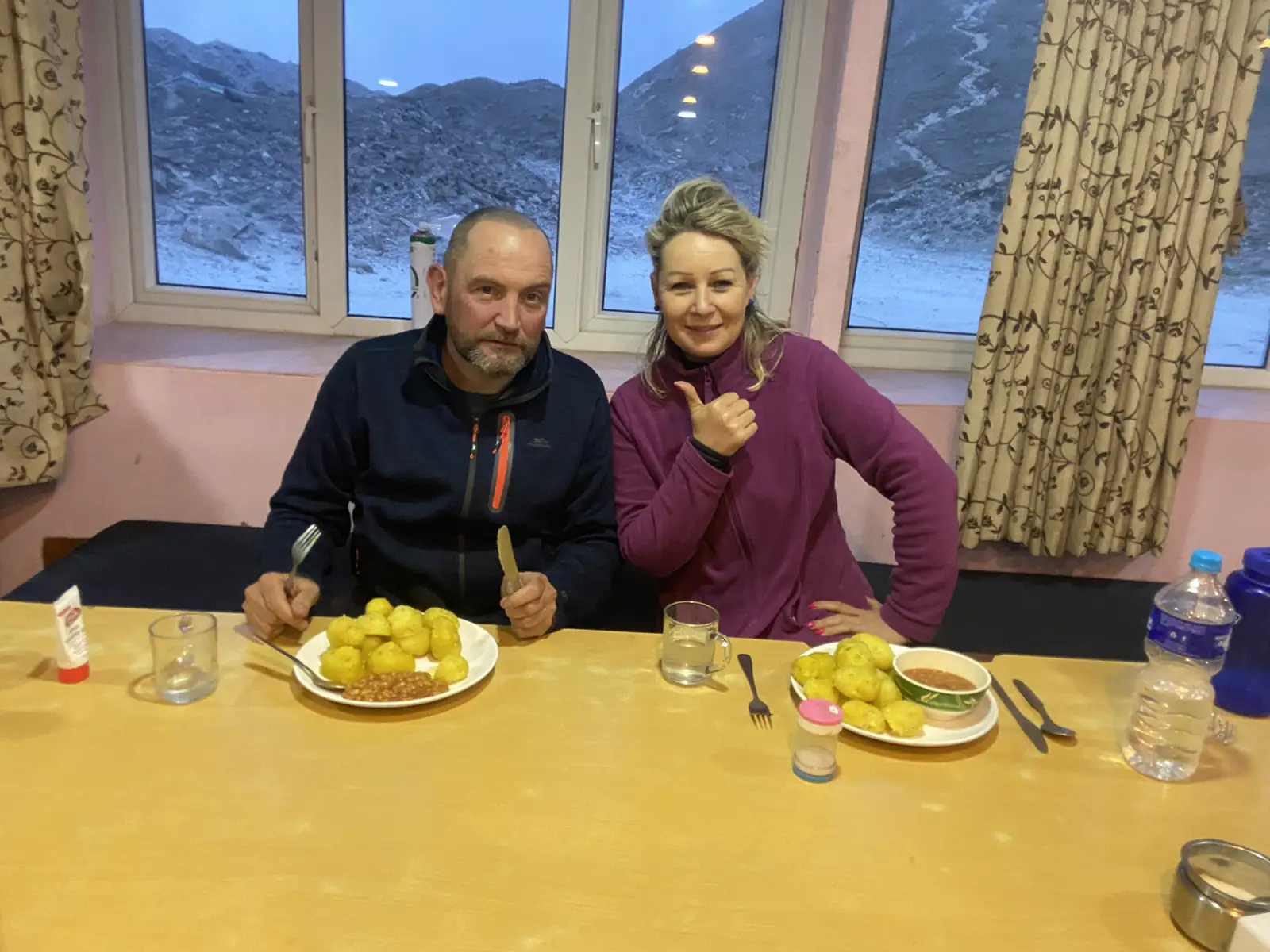
The landscape unfurled, revealing majestic mountain peaks such as Khumutse, Mahalangur Himal, and Lingtren. As the day waned, we were treated to a divine sunset, casting a golden hue over Pumori. The silhouette of Mt. Nuptse loomed in the distance, beckoning us forward. As our trek progressed, the path became more forgiving, leading us gently into the serene valley of Lobuche. Here, amidst the tranquil embrace of the mountains, we settled in for the night.
Meals: Breakfast, Lunch, and Dinner
Day 09: Trek to Gorakshep (5170 meters) and EBC (5364 meters) 13 km distance, Approx 8 hours
As dawn breaks and the sun casts its shimmering rays upon the mountain ranges, we’ll have already set forth on our journey. This day, while demanding, promises unparalleled rewards. The valley, bathed in a golden hue, unveils the splendor of the golden Himalayas.
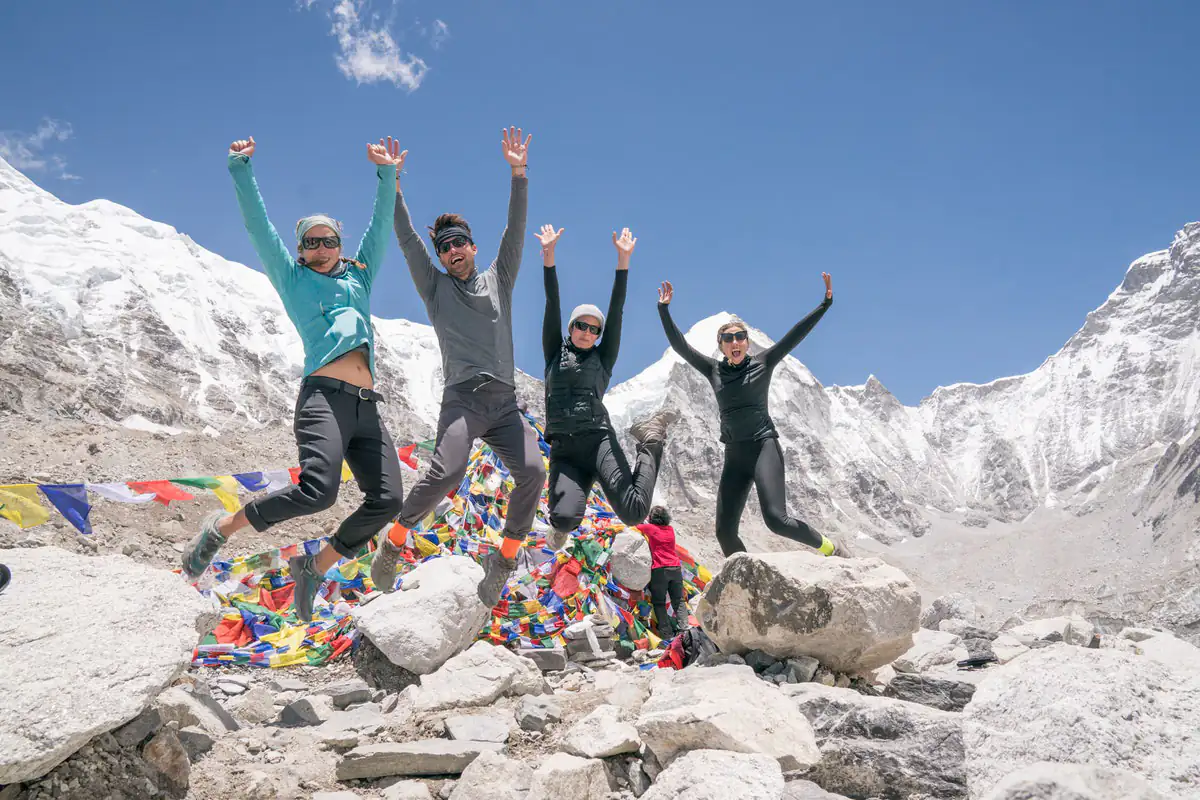
The trek’s challenge amplifies with the thinning air, making each step a testament to one’s endurance. The path can be deceptive, but with the guidance and expertise of seasoned Sherpas, we navigate with confidence. Following the contours of the Khumbu Glacier, a three-hour trek brings us to the quaint settlement of Gorak Shep. With its smattering of lodges, this hamlet offers respite and awe-inspiring mountain vistas.
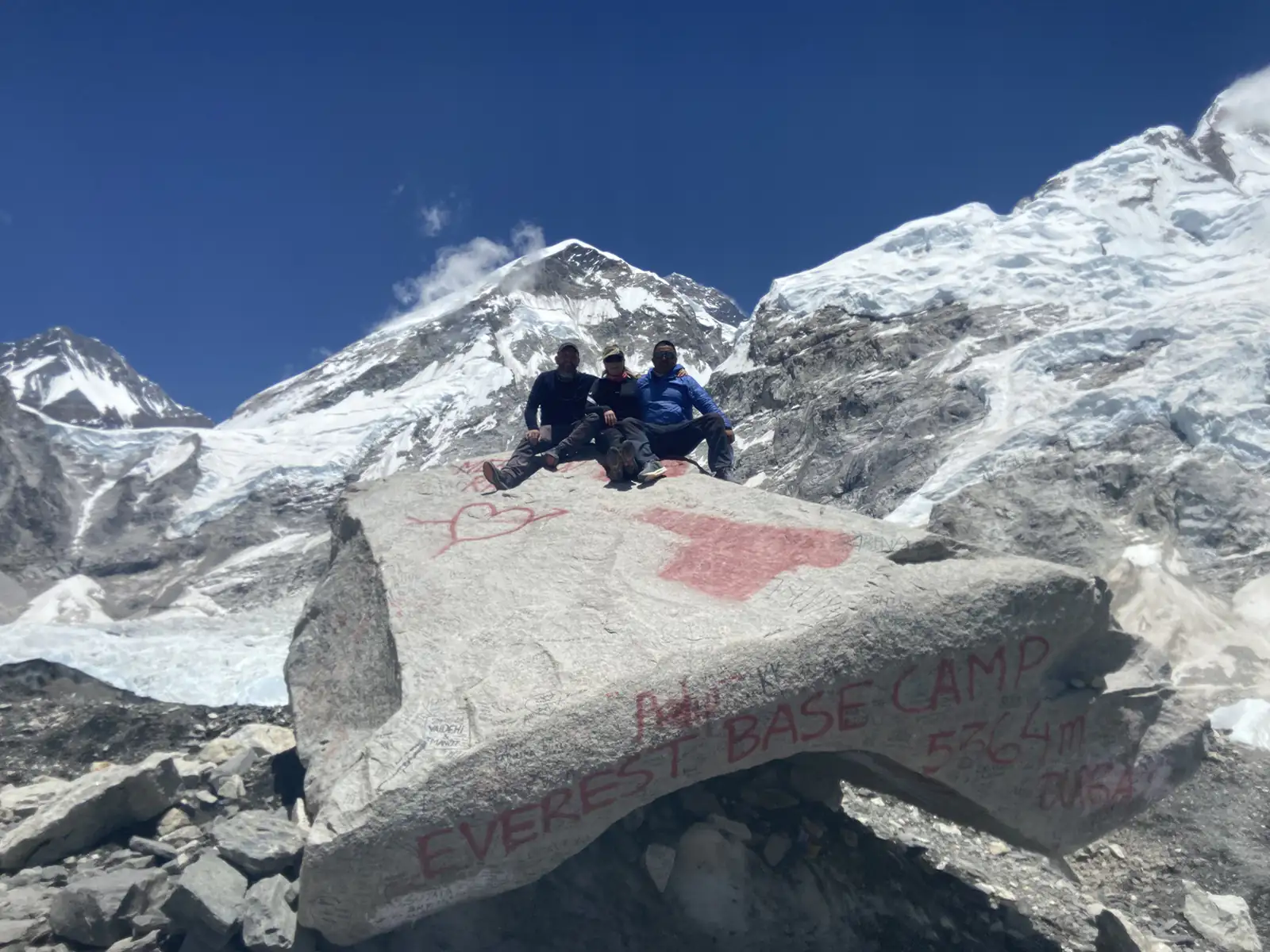
But our adventure doesn’t end here. With the Khumbu Glacier guiding our path, we press on, leading us to the iconic Everest Base Camp. The experience is nothing short of magical. Surrounded by towering peaks, the vibrant hues of the camps stand in stark contrast to the stark landscape. This is a moment for capturing memories – through photographs, shared stories, and the sheer joy of being amidst such grandeur. Take the time to wander, soak in the beauty, and connect with fellow travelers.
As the day draws closer, we retrace our steps to Gorak Shep, where we’ll find rest and reflection under the starlit Himalayan sky.
Meals: Breakfast, Lunch, and Dinner
Day 10: Trek to Kala Patthar (5545 meters) for sunrise view and fly back to Kathmandu
Today, we rose early, eager to journey to Kala Patthar amidst the dark, cold, and brisk winds. A steady 2-3 hour hike led us to the summit of Kalapatthar. A breathtaking panorama unfolded as dawn broke, with the iconic Mt. Everest taking center stage.
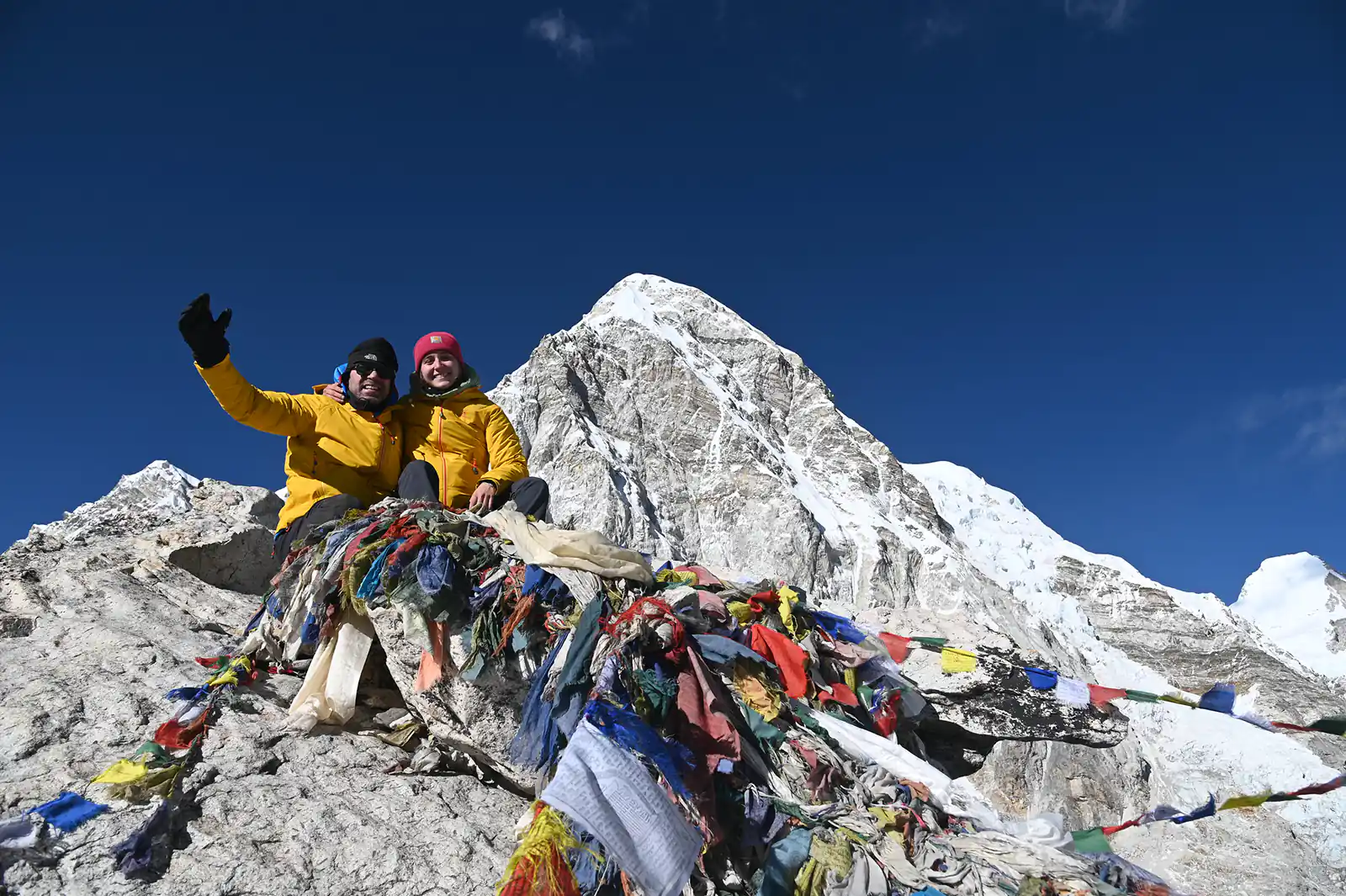
After immersing ourselves in the mountainous spectacle, we returned to Gorak Shep. The day’s excitement continued as we boarded a helicopter, offering a unique aerial perspective of the landscapes we had traversed. Gliding over the serene Gokyo Lakes and observing our trails from above was a surreal experience. With cherished memories of our time at the Everest base camp, we returned to the vibrant city of Kathmandu.
Meals: Breakfast and Dinner
Day 11: Final departure
The moment to bid farewell has come. As the day of departure dawns, you’ll have a window after breakfast to pick up a few souvenirs to remember your journey. As the day progresses, one of our team members will accompany you to the airport, ensuring a smooth departure. We recommend arriving at least two hours before your flight to navigate the check-in and security processes easily.
Safe travels!
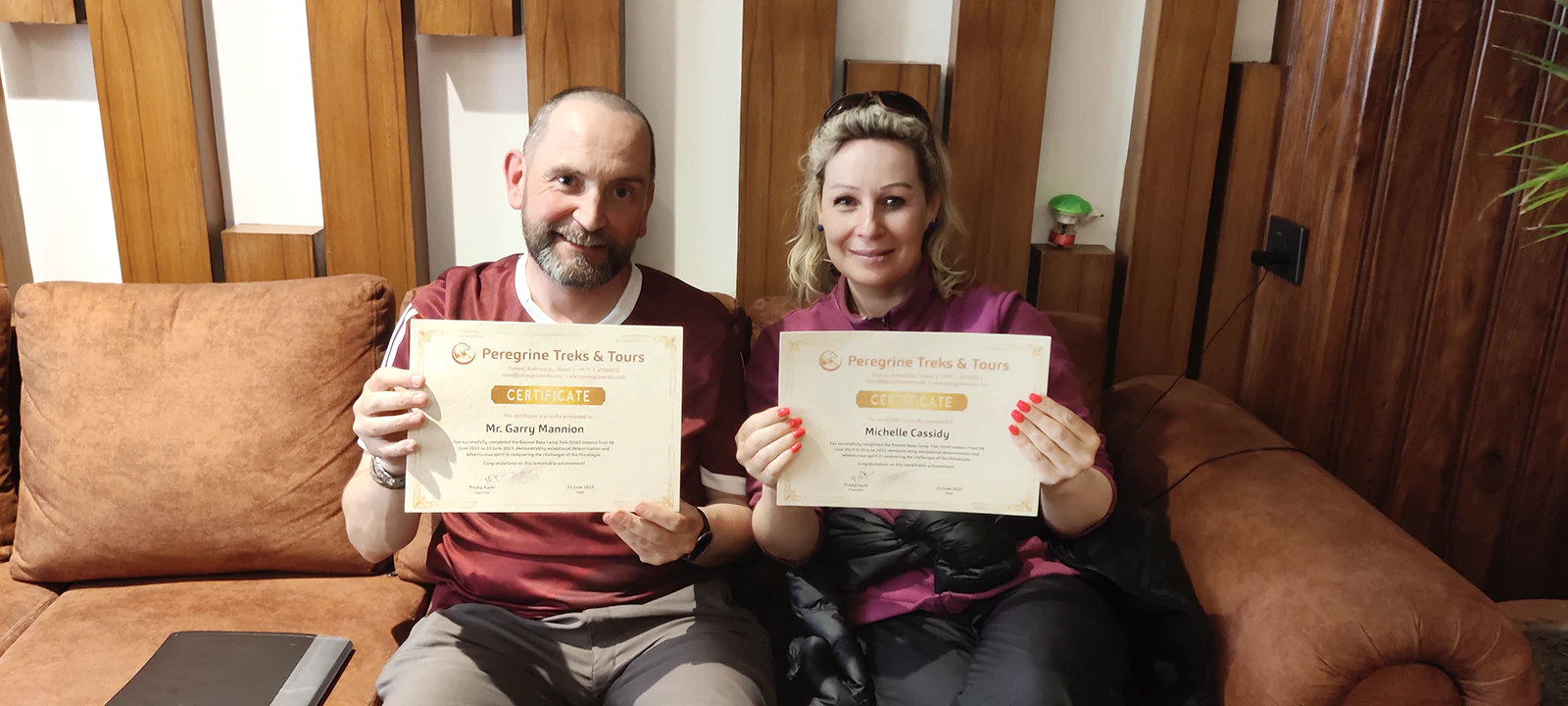
Customize this trip with help from our local travel specialist that matches your interests.
Includes & Excludes
What is included?
- Personalized pick-up and drop-off services at domestic and international airports via private vehicles.
- The Everest Hotel in Kathmandu, complete with a bed and breakfast plan
- A scenic flight from Kathmandu to Lukla, including all airport taxes.
- Exclusive chartered helicopter service from Gorakshep, tailored to the itinerary.
- Gourmet meals thrice daily at lodges during the trek.
- Expert guidance from our seasoned trekking guides, complemented by dedicated porters at a 2:1 guest-to-porter ratio.
- Comprehensive coverage for our guides and porters, including competitive wages, comfortable accommodation, and insurance throughout the trek.
- All-inclusive Everest Base Camp Trek with Helicopter Return, featuring a helicopter return tour, complete with Sagarmatha National Park Permit, local taxes, TIMS, and all associated documentation.
- A well-equipped first aid medical kit for the trekkers’ and our crew’s safety and well-being.
- All applicable government levies, VAT, and our signature office service charge.
What is excluded?
- Meals in Kathmandu, except breakfast.
- Additional hotel stays in Kathmandu beyond the itinerary for any unforeseen reasons.
- International flight fares, travel insurance premiums, and visa processing fees.
- Personal expenditures include phone bills, laundry services, bar tabs, beverages, and hot showers while in the trekking regions.
- Gratuities for guides, porters, and drivers.
- Any other expenses not explicitly mentioned in our package’s ‘included’ section.
Departure Dates
We also operate Private Trips.
Route Map
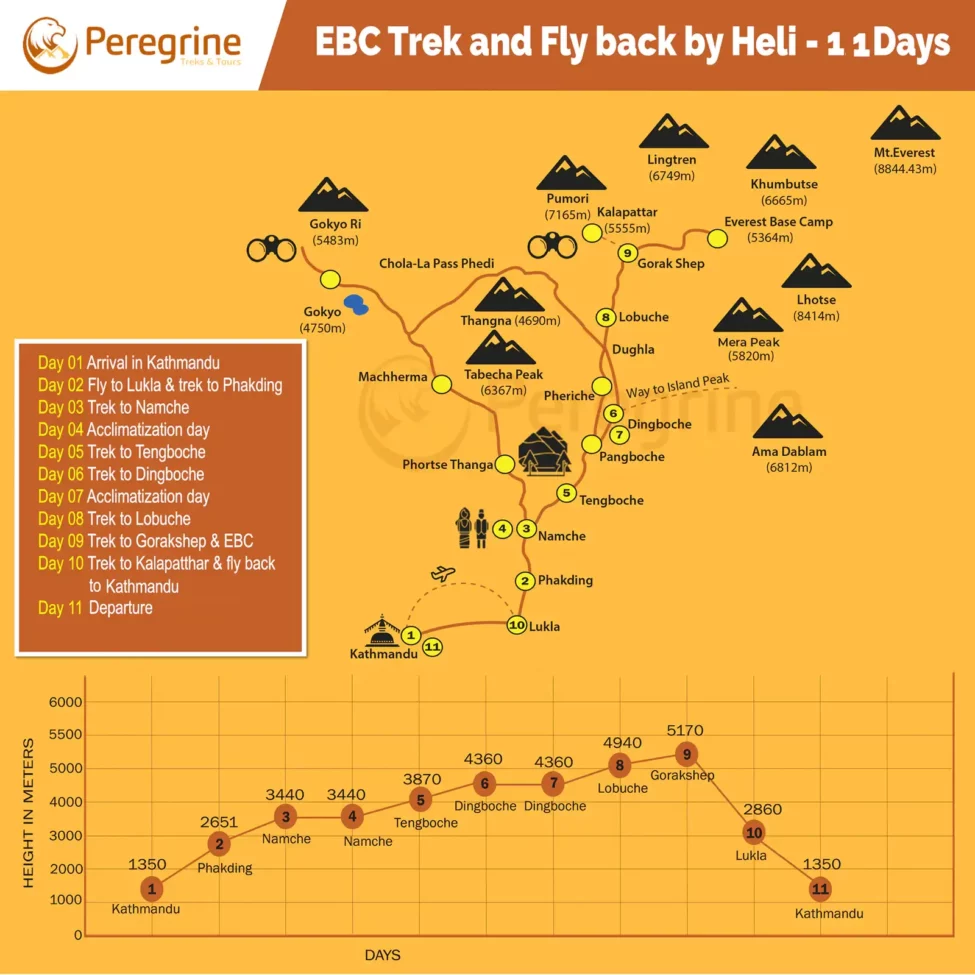
The Everest Base Camp Trek with Helicopter Return Map offers a unique and efficient way to experience the awe-inspiring Himalayas. This carefully designed map guides trekkers through the iconic Everest region. It incorporates a helicopter return option, providing an unforgettable journey that combines the thrill of trekking with the convenience of a breathtaking aerial experience. With clear trail markings, elevation details, and highlighted points of interest, this map ensures seamless navigation. From setting foot on Everest Base Camp to soaring above its majestic peaks, trekkers can savor the best of both worlds while immersing themselves in the region’s natural beauty and cultural richness.
Good To Know
An Everest Base Camp Trek with Helicopter Return requires careful planning and packing. Here’s a comprehensive packing list to ensure you’re well-prepared for the trek and the helicopter ride:
Clothing:
1. Base Layers:
- Moisture-wicking thermal tops and bottoms (2-3 pairs)
- Underwear (5-7 pairs)
2. Mid Layers:
- Fleece or lightweight down jacket
- Trekking shirts (short and long-sleeved, 3-4)
- Trekking trousers (2 pairs)
3. Outer Layers:
- Waterproof and windproof jacket (with hood)
- Waterproof trekking pants
- Down jacket (for colder temperatures at higher altitudes)
4. Footwear:
- Trekking boots (well broken in)
- Sandals or comfortable shoes (for evenings)
- Woolen or thermal socks (5-7 pairs)
- Gaiters (for snow or rain)
5. Head and Hand Gear:
- Warm beanie or hat
- Sun hat or cap
- Buff or neck gaiter
- Sunglasses with UV protection
- Lightweight gloves
- Insulated gloves or mittens
Gear and Equipment:
1. Backpack:
- Duffle Bag (Peregrine Treks will provide this)
- 150-20 Liter backpack
- Rain cover for the backpack
2. Sleeping:
- 4-season sleeping bag
- Sleeping bag liner (optional)
3. Trekking:
- Adjustable trekking poles
- Headlamp with extra batteries
4. Helicopter Ride:
- Earplugs (helicopters can be loud)
- Compact camera or phone (for aerial shots)
Personal Items:
1. Toiletries:
- Toothbrush and toothpaste
- Biodegradable soap and shampoo
- Face and body wipes
- Hand sanitizer
- Sunscreen and lip balm with SPF
- Quick-drying towel
- Toilet paper and pee funnel for women
2. First Aid and Medications:
- Personal medications
- Diamox (for altitude sickness, consult with a doctor)
- Pain relievers
- Band-aids and blister plasters
- Antiseptic wipes
- Throat lozenges
- Water purification tablets or a water filter
3. Miscellaneous:
- Water bottles or hydration bladder (at least 1L capacity)
- Snacks (energy bars, trail mix, etc.)
- Portable charger or power bank
- Camera, memory cards, and extra batteries
- Notebook and pen
- Swiss army knife or multitool
- Ziplock bags (for waste and organizing)
- Cash (small denominations)
4. Documents:
- Passport and photocopies
- Trekking permits
- Travel insurance documents
- Emergency contact information
5. Optional:
- Reading materials or e-books
- Playing cards or travel games
- Trekking map
- Compass or GPS
Remember, while packing, it’s essential to consider the weight as you’ll be trekking with your backpack. The helicopter ride might have weight restrictions, so checking with the helicopter company in advance is a good idea. Always prioritize essential items and consider the season and expected weather conditions during your trek.
Trekking Gear Essentials
Ensuring the right trekking gear essentials is paramount when embarking on the Luxury Everest Base Camp Trek with Helicopter Return. Sturdy and comfortable trekking boots provide the foundation for a successful journey, paired with moisture-wicking clothing that facilitates layering to adapt to changing temperatures.
Weather-appropriate outerwear, including a reliable jacket and rain gear, safeguards against the Himalayan elements, while sunglasses and a wide-brimmed hat offer essential sun protection. Trekking poles enhance stability on challenging terrains, and a well-designed backpack with proper weight distribution is indispensable for carrying essentials. Equipped with a basic first aid kit and necessary medications, trekkers can confidently navigate the trails and fully embrace the luxury and adventure of this extraordinary trek.
Helicopter Journey Considerations
When undertaking the Luxury Everest Base Camp Trek with Helicopter Return, factoring in the helicopter journey aspects is essential. As you transition from trekking to soaring, a windproof jacket and gloves are vital for warmth and comfort during the helicopter flight. This enables you to fully appreciate the awe-inspiring aerial vistas in a state of utmost luxury.
Don’t forget to capture these extraordinary moments with a camera, preserving memories of this unique experience for a lifetime. Pack a few light snacks and water for the flight, ensuring you’re well-prepared for the exhilarating trekking adventure and the awe-inspiring helicopter journey.
Packing Lightly
Packing lightly is a cardinal principle when preparing for the Luxury Everest Base Camp Trek with Helicopter Return. Streamlining your belongings to the essentials ensures freedom of movement and convenience throughout the journey. Opt for multi-functional clothing items that serve various purposes and consider the versatility of each piece.
By minimizing unnecessary items, you reduce your weight and enhance your overall trekking experience. This allows you to fully appreciate the luxury and grandeur of the Himalayas without unnecessary encumbrance.
Using Quality Equipment and Clothing
Using quality equipment and clothing is paramount when embarking on the Luxury Everest Base Camp Trek with Helicopter Return. Reliable and durable gear enhances your comfort and safety and contributes to the overall enjoyment of the journey.
Investing in well-constructed trekking boots, moisture-wicking clothing, and sturdy trekking poles ensures you’re well-prepared to navigate the Himalayas’ varying terrains and ever-changing weather conditions. Choosing trusted brands and thoroughly testing your equipment before the trek guarantees optimal performance and resilience, allowing you to fully immerse yourself in this unique trek’s luxury and adventure.
Where to Buy Trekking Gear
When considering where to purchase trekking gear, options abound. You can buy in your home country or explore Thamel, Kathmandu, renowned for its trekking shops. At the same time, it is recommended that you purchase quality clothing in your home country or from reputable shops in Thamel.
Trekking essentials like poles, headlamps, and water bottles can be bought from local markets. The estimated cost for obtaining all required clothing and equipment in Nepal typically ranges from USD 500 to 800 per person. Choosing between your home country and the bustling markets of Thamel ultimately ensures your Luxury Everest Base Camp Trek with Helicopter Return.
Additional Tips for a Successful Trek
Additional tips can make all the difference for a successful Luxury Everest Base Camp Trek with Helicopter Return. Keeping an eye on local weather forecasts helps you pack appropriately for the changing conditions of the Himalayas. Adhering to local cultural norms and dress codes shows respect for the communities you encounter along the journey.
Staying well-hydrated, fueling your body with nutritious meals, and listening to your body’s signals contribute to your overall well-being. Lastly, ensuring you have essential travel documents and permits readily accessible ensures smooth passage. It lets you focus on embracing the luxurious adventure and breathtaking vistas this extraordinary trek offers.
We accept a broad range of major currencies to make your booking process seamless and convenient. These include the US Dollar, British Pound, Euro, Australian Dollar, Singapore Dollar, Indian Rupee, Swiss Franc, Canadian Dollar, Japanese Yen, Chinese Yuan, Saudi Arabian Riyal, Qatari Riyal, Thai Baht, UAE Dirham, Malaysian Ringgit, South Korean Won, Swedish Krona, Danish Krone, Hong Kong Dollar, Kuwaiti Dinar, and Bahraini Dinar. Whether booking the Everest Base Camp Trek with Helicopter Return or any other service, you can make payments in any of these currencies for a smooth transaction.
In Nepal, the electrical system operates at 230V with a 50Hz frequency. The power outlets are typically Type C, D, and M. If your home country uses a different plug type, it’s important to bring a suitable adapter. A universal adapter is highly recommended, as it ensures your devices can be charged without issues. Additionally, check that your appliances are compatible with 230V to avoid potential damage or malfunctions.
It’s advisable to consider certain vaccinations before traveling to Nepal, such as Hepatitis A, Typhoid, and Tetanus. Vaccines for Rabies, Japanese Encephalitis, and Malaria may also be recommended depending on your itinerary and planned activities. However, no vaccinations are required for entry into the country. Consult your doctor beforehand for guidance tailored to your health needs and travel plans.
Our website accepts USD, CAD, GBP, Euro, and AUD payments. If you live in a country that uses any of these currencies, you can make payments directly from your bank account, which helps you avoid the 3% credit card processing fee. To secure your booking for the Everest Base Camp Trek with Helicopter Return, a deposit of at least 30% of the total cost is required. The remaining balance should be settled 30 days before your arrival. We also accept payments through Visa, Maestro, MasterCard, American Express, and other major credit cards. Still, please remember that credit card processing fees are additional and not included in the tour cost.
We highly recommend getting a SIM card for dependable internet access during your stay in Nepal. Nepal Telecom (government-owned) and NCELL (privately owned) are the two main providers. It’s best to purchase your SIM card at the airport, where staff can help you activate and select a suitable data plan. Having a SIM card will make contacting us and locating our airport representative easier. Alternatively, eSIMs are also available at Kathmandu Airport.
Free WiFi is accessible until Namche Bazaar, but from Day 5 of your trek onward, you will need to buy an internet package at the lodge, typically priced at USD 6-7 for 24 hours of WiFi. Remember that this internet access can only be used within the lodge premises.
You can use your phone and mobile data in areas with strong signals like Lukla, Namche, and Tengboche. We suggest using an NTC SIM card over NCELL for better data reliability. Mobile data may work sporadically in Dingboche and Gorakshep, but in Lobuche and Pheriche, mobile data access is generally unavailable.
Until you reach Namche Bazaar, charging your electronic devices like mobile phones, cameras, and power banks is free. Beyond Namche, lodges typically charge around 4-5 USD to power up your gadgets. Electricity is generally accessible throughout the Luxury Everest Base Camp Trek. For added comfort, you can also request an electric blanket for an extra cost of 15-20 USD per night.
Trip Information
The Everest Base Camp Trek with Helicopter Return isn’t just your usual walk in the mountains; it’s like stepping into the very heart of the Himalayas. On this journey, you’ll be surrounded by stunning views, get to know the local Sherpa community, and challenge yourself near the sky-touching peaks.
But here’s the best part: instead of walking back, you get to hop on a helicopter! Imagine flying over those vast mountains and seeing the winding paths you trekked. This mix of adventure and a touch of luxury makes the EBC Trek with Helicopter Return a truly one-of-a-kind experience.
The Adventure Awaits
The Himalayas, a vast and majestic mountain range, has always been a siren call for those with a spirit of adventure. These mountains, towering peaks, and deep valleys have been the backdrop for countless tales of exploration, conquest, and spiritual awakening. For many, the Himalayas represent the ultimate frontier, a place where one can test their limits against the raw power of nature and find a deeper connection with the world around them.
The Luxury Everest Base Camp Trek with Helicopter Return showcases the magnetic charm of these peaks. This trek is not just a physical journey but a deep dive into the heart of the Himalayas. As trekkers make their way through rugged terrains, they are presented with a constantly changing tapestry of landscapes, from dense forests to glacial expanses. Every step on this trail brings a sense of accomplishment, a feeling of being one with the mountains, and the thrill of venturing into the unknown.
But what truly sets the Helicopter Trek to Everest apart from other treks is the unique blend of experiences it offers. While the journey to the base camp immerses one in the rich tapestry of nature and culture the region offers, the helicopter return adds a touch of luxury and a different perspective to the adventure. Imagine, after days of challenging trekking, being whisked away into the skies, getting a bird’s-eye view of the very trails you conquered, and seeing the vastness of the Himalayas unfold beneath you.
Prioritizing Your Safety on the Everest Base Camp Trek with Helicopter Return
The awe-inspiring beauty of the Himalayas comes with inherent challenges. At Peregrine Treks, your safety is our primary concern. Our motto is safety over adventure. We always prioritize safety over trekking. That’s why our Everest Base Camp Trek with Helicopter Return incorporates a comprehensive set of safety protocols, ensuring a worry-free and unforgettable experience.
Acclimatization is King:
We meticulously plan the itinerary to allow for proper acclimatization. This includes rest days strategically placed throughout the trek, allowing your body to adjust to the gradual increase in altitude. Our experienced guides closely monitor your health, looking for any signs of altitude sickness.
In trekking itineraries, acclimatization days in Namche Bazaar and Dingboche are often marked as rest days, but in reality, they are critical for preparing your body for higher altitudes. These days are not about rest; they involve strategic hikes to higher elevations followed by a return to a lower altitude for sleeping, which is key to minimizing the risk of altitude sickness.
In Namche Bazaar, a recommended acclimatization exercise is hiking to Khumjung Village and then returning to Namche. This hike helps you adjust to the altitude while strengthening your ability for the upcoming trek days. Walking to Khumjung increases your elevation slightly, and returning to Namche for the night aids in better acclimatization.
Similarly, in Dingboche, an effective acclimatization hike is to Nagarjun Hill. This involves a climb to a higher altitude followed by a descent back to Dingboche for the night. Spending time at higher altitudes during the day and then sleeping at lower altitudes helps your body adapt to the reduced oxygen levels. It significantly lowers the chances of developing Acute Mountain Sickness (AMS).
These acclimatization hikes are crucial; they involve going to a higher altitude, staying for about an hour, and then returning to a lower altitude. This practice is proven to enhance your body’s adaptation to the thin air and improve your overall trekking experience by making you feel more comfortable and better prepared for the ascent ahead.
Experience You Can Trust:
Our guides are not just well-versed in the Everest region but certified wilderness first responders equipped to handle medical emergencies. Their training fully ensures the highest level of competence and preparedness. Furthermore, they possess an intimate understanding of the local terrain, weather patterns, and potential hazards, allowing them to navigate the trails and make informed decisions confidently.
Safety Gear at the Ready:
We provide a comprehensive first-aid kit containing essential medications and supplies for minor injuries and illnesses. Additionally, we can access pulse oximeters to monitor oxygen saturation levels, a crucial indicator of altitude acclimatization. Depending on weather conditions, we recommend personal gear like headlamps for low-light visibility or trekking poles for added stability.
Communication is Key:
Throughout the trek, we maintain open communication channels. Our guides are equipped with local phones, ensuring constant contact with our base camp and emergency medical services in case of unforeseen circumstances. We also encourage clear communication between you and your guide, promptly reporting any health concerns or physical limitations.
Helicopter Evacuation:
While highly unlikely, we prioritize your well-being by including helicopter evacuation coverage in our package. This provides peace of mind, knowing that a swift and safe evacuation to a medical facility is readily available in the event of a severe medical emergency.
Pre-Departure Briefing:
Before starting the trek, we conduct a thorough pre-departure briefing. This session covers essential information about the itinerary, safety protocols, proper use of first-aid kits, and what to expect in terms of altitude and weather conditions. We encourage open communication during this briefing and address any questions or concerns you may have.
Your Safety is Our Commitment:
By prioritizing these safety measures, Peregrine Treks strives to maintain a situation where you can fully immerse yourself in the majesty of the Himalayas, confident that your well-being is in the hands of experienced professionals. Book your Everest Base Camp Trek with Helicopter Return today and start on a safe and unforgettable adventure!
Why Luxury Everest Base Camp Trek with Helicopter Return?
Mountains have always fascinated us, with Mount Everest reigning supreme. Its towering presence and tales of human conquest make it iconic. The Luxury Everest Base Camp Trek with Helicopter Return, set in Everest’s shadow, epitomizes adventure and the pursuit of the extraordinary.
The Allure of Everest
At 8,848 meters, Mount Everest is more than a peak; it’s a testament to nature’s might and human tenacity. Its history is rich with stories of triumphs and heartbreaks, elevating it from a mere mountain to a symbol of human challenge. For many, being near Everest is a lifelong dream. The Everest Base Camp Helicopter Return brings this dream to life, offering an intimate experience of Everest without the risks of summiting.
‘Everest’ is synonymous with awe and challenge. Its unpredictable conditions make it a climber’s ultimate test. Yet, the Everest Base Camp with Helicopter Return offers a safer yet thrilling experience. As trekkers near the base camp, breathtaking views of Everest greet them. The helicopter return adds luxury, giving a bird’s-eye view of the traversed landscapes.
A Journey to the Rooftop of the World
The Everest Base Camp Trek with Helicopter Return is more than a trek; it’s a historical journey. Each step echoes the endeavors of past mountaineers, making the trek a living museum of mountaineering tales.
The Himalayas’ beauty is unmatched, and this trek immerses participants in it. The hike presents varied scenery, from verdant woods to highland fields and charming hamlets to icy stretches. These ever-changing and vast landscapes remind trekkers of nature’s grandeur and our fleeting presence within it.
Beyond the physical, the trek is a spiritual odyssey. The Himalayas’ vastness prompts introspection and connection. The panoramic vistas, pure air, and the achievement of reaching the base camp combine to make the Luxury Everest Base Camp Trek Helicopter Return a transformative, soulful journey to the world’s rooftop.
Sherpa Culture and Hospitality
Amidst the grandeur of the Himalayas, the Sherpa community has flourished, becoming an integral part of the Luxury Everest Base Camp Trek with Helicopter Return experience. Known worldwide for their unmatched mountaineering expertise, Sherpas are also the custodians of a rich cultural heritage deeply rooted in Tibetan Buddhism. As the trek participants go through the trails, they encounter quaint Sherpa villages, where the harmonious blend of nature and culture is palpable. The musical chimes of prayer wheels and the vibrant hues of prayer flags are familiar sights, symbolizing blessings and goodwill.
The traditional stone dwellings, ancient monasteries, and the omnipresent mountain backdrop paint a picture of serenity. However, the real essence of the Sherpa culture lies in their unparalleled hospitality. As trekkers navigate the Everest Base Camp Trek with Helicopter Return, they are often invited into Sherpa homes, where stories, legends, and traditional meals are generously shared. This cultural immersion transforms the trek from a mere adventure to a profound journey of understanding and connection.
The tales of mountain legends, the lively Sherpa festivals, and their deep spiritual practices provide trekkers with a unique perspective on life in the high Himalayas. Engaging with the Sherpa community during the Everest Base Camp Trek Helicopter Return enriches the experience, making it a holistic journey that touches both the heart and soul.
Flora and Fauna En-route
The Everest Base Camp Trek with Helicopter Return is not just a showcase of towering peaks; it’s a journey through diverse ecosystems teeming with life. As trekkers embark on this adventure, they traverse through lush rhododendron forests, which burst into a riot of colors during the blooming season, enhancing the visual appeal of the trek.
The region’s biodiversity is truly astounding. Rare and majestic creatures like the snow leopard, the vibrant Himalayan monal, and the Himalayan Tahr can be spotted along the trails, adding a touch of wilderness magic to the Everest Base Camp Helicopter Return. The sheer joy of possibly catching a glimpse of a snow leopard in its natural habitat or observing a monal in all its splendor is a bonus for nature enthusiasts.
As the altitude increases, the landscape transforms. Dense woodlands transition into alpine meadows and eventually into stark, glacial terrains. Each zone, with its distinct flora and fauna, offers a fresh perspective on the adaptability of life in the Himalayas. The Everest Base Camp, Trek Helicopter Return, is not just a trek; it’s a celebration of nature in all its forms.
What Makes the Helicopter Return Special?
The Everest Base Camp Trek, paired with a Helicopter Return, merges thrill and luxury. The hike plunges adventurers into the Himalayan essence, while the helicopter descent infuses the trip with splendor.
This isn’t merely about returning to the starting point; it’s about relishing the landscapes from an entirely new vantage point. As you soar above the trails you’ve just traversed, you gain a panoramic perspective of the vastness and beauty of the region. This bird’s-eye view saves trekkers time and provides a thrilling aerial tour, making the EBC Trek with Helicopter Return a unique adventure.
Best Time for Luxury Everest Base Camp Trek with Helicopter Return
From March to May, the pre-monsoon period offers trekkers a chance to witness the mountains as they shake off the winter snow, revealing lush landscapes beneath. On the other hand, the post-monsoon months, from late September to November, present clear skies and crisp air, perfect for both trekking and aerial views. These periods ensure optimal conditions, balancing safety and visual delight. Thus, for those seeking a memorable trek and a captivating helicopter ride, these months are ideal for the Luxury Everest Base Camp Trek with Helicopter Return.
Preparing for the Trek
Physical Fitness
The Everest Base Camp Trek with Helicopter Return is no ordinary journey; it demands mental and physical preparedness. Given the altitude and terrain challenges, being in peak physical condition is essential. Regular cardiovascular exercises like running or cycling can help build stamina.
Strength training is equally important, ensuring your muscles are ready for the trek’s demands. Additionally, altitude-specific workouts can acclimatize your body to the reduced oxygen levels you’ll encounter. Committing to a fitness regimen at least three months in advance will ensure you’re well-prepared for the Everest Base Camp Helicopter Return.
Packing Essentials
Packing for the Everest Base Camp Trek with Helicopter Return is a delicate balance between preparedness and practicality. Layered clothing is essential, allowing trekkers to adjust to fluctuating temperatures. Sturdy trekking boots are necessary, ensuring comfort and safety on varied terrains. A comprehensive first-aid kit can be a lifesaver, addressing minor injuries or ailments. Additionally, securing permits required in advance will ensure a hassle-free journey.
While it’s tempting to pack for every scenario, it’s vital to remember the importance of traveling light. After all, the Everest Base Camp Trek with Helicopter Return is about enjoying the journey and not being burdened by excess baggage.
Distance and Duration Details for the Luxury Everest Base Camp Trek with Helicopter Return
Starting on the Everest Base Camp Trek with a helicopter return involves covering a daily distance of approximately 13 to 15 kilometers over 5 to 6 hours of trdailyach day. Due to its extended duration and rugged terrain, this trek is known for its challenging nature, requiring not only endurance but also careful planning.
The entire route to Everest Base Camp covers a distance of about 130 kilometers, making preparation essential for a successful journey. Equipping yourself with the right gear and ensuring good physical fitness will help you navigate the iconic trail with greater ease and enjoyment. Proper preparation allows you to experience this trek’s breathtaking views and memorable experiences fully.
Detailed Itinerary Breakdown
Lukla to Phakding
- Starting Elevation: 9,100 ft / 2,800 m
- Ending Elevation: 8,563 ft / 2,610 m
- Oxygen Levels: Starting at 72% and ending at 74% of sea level
- Distance: 4.66 mi / 7.5 km
- Duration: 3 hours
Phakding to Namche Bazaar
- Starting Elevation: 8,563 ft / 2,610 m
- Ending Elevation: 11,286 ft / 3,440 m (Namche Bazaar)
- Oxygen Levels: Starting at 74% and ending at 70% of sea level
- Distance: 5 miles / 8.0 km
- Duration: 6 hours
Namche Bazaar to Deboche/Tengboche
- Starting Elevation: 11,290 ft / 3,440 m
- Ending Elevation: 12,687 ft / 3,867 m
- Elevation Gain: +1,397 ft / 427 m
- Oxygen Levels: Starting at 67% and ending at 64% of sea level
- Distance: 5.72 mi / 9.2 km
- Duration: 6 hours
Tengboche/Deboche to Dingboche
- Starting Elevation: 12,697 ft / 3,870 m
- Ending Elevation: 14,469 ft / 4,410 m
- Elevation Gain: +1,772 ft / 540 m
- Oxygen Levels: Starting at 64% and ending at 59% of sea level
- Distance: 6.71 mi / 10.8 km
- Duration: 5.5 hours
Dingboche to Lobuche
- Starting Elevation: 14,469 ft / 4,410 m
- Ending Elevation: 16,109 ft / 4,910 m
- Elevation Gain: +2,008 ft / 612 m (Net Gain: 1,640 ft / 500 m)
- Distance: 4.9 mi / 7.9 km
- Duration: 5 hours
Lobuche to Gorakshep
- Starting Elevation: 16,142 ft / 4,920 m
- Ending Elevation: 16,863 ft / 5,140 m
- Elevation Gain: +721 ft / 220 m
- Oxygen Levels: Starting at 56% and ending at 54% of sea level
- Distance: 2.67 mi / 4.3 km
- Duration: 3 hours
Gorakshep to Everest Base Camp (EBC)
- Starting Elevation: 16,863 ft / 5,140 m
- Ending Elevation: 17,598 ft / 5,364 m
- Elevation Gain: +735 ft / 224 m
- Oxygen Levels: Starting at 54% and ending at 53% of sea level
- Distance: 2.17 mi / 3.5 km
- Duration: 2 hours to reach EBC (4.5 hours round trip)
Ensuring you are adequately prepared, both physically and mentally, for the trek will help you enjoy this once-in-a-lifetime journey to Everest Base Camp, taking in some of the most stunning landscapes in the Himalayas and creating lasting memories.
The Trip: Step-by-Step
Everest Base Camp Trek with Helicopter Return is a transformative experience. It offers trekkers a blend of adventure, culture, and natural beauty. Each segment of the journey presents its unique highlights, ensuring that the trek remains etched in memory for a lifetime.
Setting Off: Kathmandu to Lukla
The adventure starts with a flight from the bustling city of Kathmandu to Lukla. This flight is often dubbed one of the most exhilarating in the world, offering passengers breathtaking views of the Himalayan range. Lukla, perched high in the mountains, is more than just an airport; it’s the gateway to the Everest region. As trekkers set foot here, the crisp mountain air and the scenic beauty set the tone for the epic journey ahead on the Everest Base Camp Trek return by helicopter.
Exploring Namche Bazaar
Namche Bazaar, often called the Sherpa capital, is a melting pot of cultures. As trekkers enter this bustling town, they are greeted by a symphony of sounds, from traders haggling to trekkers sharing tales. The city, with its winding paths and colorful markets, offers a glimpse into the daily life of the Sherpa community. But beyond commerce, Namche Bazaar is a vantage point, offering trekkers panoramic views of the snow-capped peaks, further enhancing the Everest Base Camp Trek with Helicopter Return experience.
The Ascent to Everest Base Camp
From Namche, the trail becomes a visual treat. Trekkers navigate through a myriad of terrains, each with its unique charm. The dense rhododendron forests, with their vibrant blooms, give way to glacial moraines as one ascends. With every step, the majestic peaks of the Himalayas seem to come closer, offering trekkers a constantly evolving backdrop. The culmination of this ascent is the Everest Base Camp, a place that symbolizes human ambition and endurance. Standing there, one can’t help but feel a deep sense of accomplishment.
The Thrilling Helicopter Return
The Everest Base Camp Trek with Helicopter Return adds a touch of luxury to the adventure. After days of challenging trekking, the helicopter ride is not just a mode of return but a reward. As trekkers soar above the landscapes they’ve just navigated, they get a bird’s-eye view of the region’s vastness. This aerial perspective, combined with the thrill of flying amidst the towering peaks, ensures the return journey is as memorable as the trek.
Safety Precautions and Tips
Safety must always be a priority, particularly in demanding landscapes like Everest. Staying informed and vigilant can turn a potentially risky journey into a memorable expedition.
Altitude sickness is a genuine concern, and trekkers should be vigilant about its symptoms. Acclimatizing, staying hydrated, and listening to one’s body is essential. Pushing oneself too hard can be detrimental.
Another crucial tip is to trek at a pace that feels comfortable. It’s not a race; it’s a journey to be savored. Hiring a local guide can be invaluable for those unfamiliar with the region. They ensure you stay on the right path and enrich the trekking experience by sharing insights into the region’s history, culture, and legends.
Conclusion: A Trek Worth Every Step
The Luxury Everest Base Camp Trek with Helicopter Return is not just a physical journey; it’s an odyssey of the soul. It challenges trekkers, pushes their limits, and offers them nothing short of magical views. Every step taken, every hurdle overcome, and every interaction along the way adds depth to the experience. The blend of natural beauty, cultural immersion, and the thrill of adventure makes this trek genuinely unparalleled. For those who trek on it, it’s not just about reaching the base camp or enjoying a helicopter ride; it’s about discovering oneself amidst the grandeur of the Himalayas.
Additional Information
We are trying to give the correct information through this website. However, please feel free to call or email us with further queries. You can talk with us at +9779851052413 (Mobile/WhatsApp/Viber/Telegram) and +1 315 388 6163. There is no time barrier to ring those numbers.
Frequently Asked Questions
Everest Base Camp Trek with Helicopter Return refers to a trekking expedition where participants hike up to the Everest Base Camp and then return to their starting point or another designated location via a helicopter, eliminating the need to trek back down.
While the trek to Everest Base Camp can take about 11-14 days, the helicopter return reduces the descent time to just a few hours. The journey, including acclimatization days, usually lasts 15-17 days.
Yes, the helicopter services are operated by seasoned professionals familiar with the mountainous terrain. So, the Everest Base Camp Trek with Helicopter Return option is safe.
Adding a helicopter return typically increases the cost, given the luxury and convenience of a quick descent. The exact difference depends on the group size and accommodation on the trek. Please click on this link for the standard Everest Base Camp Trek.
The Everest Base Camp sits at an altitude of 5,364 meters (17,598 feet), and Kalapatthar lies at a 5545-meter altitude. This is the highest point trekkers reach before taking the helicopter return.
Most helicopters have a weight limit, usually around 480-500 kg (including passengers, pilot, and luggage). Exceeding this can be dangerous, especially at high altitudes. That’s why we recommend you minimize your luggage weight (Approx 12 Kg).
Weather in the mountains can be unpredictable. The helicopter flight may be postponed to the next available day if conditions are unfavorable. It’s always best to factor in buffer days for such contingencies.
Indeed, we recommend securing thorough travel insurance that encompasses high-altitude hikes and emergency helicopter rescues. For more details, please click here
Absolutely! The helicopter return only affects your descent. The ascent will still involve trekking through local villages, interacting with the Sherpa community, and experiencing their rich culture.
Rapid altitude changes can increase the risk of altitude sickness. While helicopters are pressurized, it’s essential to stay hydrated, avoid alcohol before the flight, and discuss any health concerns with your guide or doctor.
Always consult with Peregrine Treks and Tours for the most up-to-date and detailed answers tailored to your specific trip.
Reviews on Everest Base Camp Trek with Helicopter Return
Incredible Everest Base Camp Trek with Helicopter Return
We had a fantastic trip to Everest Base Camp Trek with helicopter return! Our guide Mingmar was knowledgeable, helpful, & funny and helped us navigate the local culture, a challenging trail, & a fantastic adventure. The trekking was tricky and ended with a challenging hike up to a beautiful morning view of Everest and a scenic ride back to Lukla.
I highly recommend Peregrine Treks to everyone planning to Nepal for Everest Base Camp Trek with Helicopter Return tour.

Marcel Vogler
GermanyEverest Base Camp Helicopter Trek
I just completed this 11-day Everest Base Camp Trek with Helicopter return. Peregrine Treks and Expedition organized the trip very well. Being a regular trekker, I found the trek challenging at some sections, but all the tiredness and stress went away by the breathtaking views of the Himalayas on reaching EBC. During the entire trek, I found myself safe with the guide and porters provided by the Peregrine Treks. They were very friendly and helpful throughout the trek. On the 10th day, I flew back to Kathmandu via Helicopter from Gorakshep. The views of the stunning snow-capped mountains from the helicopter were just exquisite. I am very thankful to Peregrine Treks and the team for making my trip successful.

Robert S. Thompkins
United StatesMemorable EBC Heli Trek
I had an incredible trekking with Peregrine Treks. The views during the trek seem out of this world, and you come away amazed. Everything was handled with complete care, and our lead guide Dawa Sherpa was knowledgeable and helpful at every stage. He constantly checked to ensure you were doing alright, and if people became sick, he looked after you. I can’t say enough about Dawa and his team of assistant guides and porters if you can ask him.
Accommodation during the Luxury Everest Base Camp Trek with Helicopter Return package is simple but best, and the foods are hygienic. We were lucky enough to be put in with a great group of mixed ages and countries of origin, and we all became quick friends. If you have been thinking about this trip, lock it in. Trust me, you won’t be disappointed with Peregrine Treks and Tours with an experienced and trained guide.

Nea Kauppi
FinlandComplecated but Highly Recommended Trek
We recently completed this Luxury Everest Base Camp Trek with Helicopter Return with Peregrine Treks. We had several complications with the flights and the itinerary due to terrible weather, but the organization handled them satisfactorily. The Everest Base Camp Helicopter Trek is a lovely path, but it isn’t easy. The ascent over Dingboche was a near-death experience. Overall, we are pleased with the firm and the organization. Thank you, Guide Nima and the entire Nepalese crew members and our beloved trekkers from different countries. We won’t get any hassles flying back from Gorak Shep to Kathmandu.

Martha F. Gower
Baldwin Park, United States